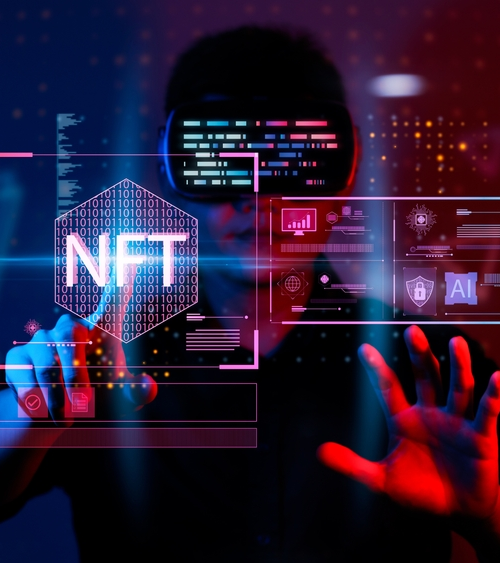Troy Warren for CNT #NFT
When you first enter the world of NFTs, you’ll come across some commonly used terms that may be hard to understand without context. This is why we’ve created this NFT glossary – an NFT dictionary with all the different terms that NFT creators and collectors need to know.
Basic NFT Terms
NFT
Stands for Non-Fungible Token. An NFT is a digital asset that is backed by the blockchain for verifiable ownership and authentication. Learn more about it in this article.
Smart Contract
A smart contract is the part of your NFT that’s not the artwork – it’s the program on the blockchain that controls the ownership and transactions of your NFT asset.
Metadata
Metadata is data about data – NFT metadata includes information about the name of an NFT, the image link, royalty rates, the original creator, and much much more.
ERC721 / ERC1155 Standards
ERC721 and ERC 1155 are technical standards for NFTs that determine the functions of an NFT smart contract and ensure compatibility.
Unlockable Content
Secret files and content that are only accessible by the first buyer of the NFT, unlocked after the NFT has been purchased. This is a great way for creators to reward their first buyers and add value to NFTs.
Wallet Address
To own an NFT, you need a crypto wallet. This wallet is a specific address on the blockchain that only you can control, and this is where your NFTs will live.
Things You Can Do To An NFT
Mint
The dictionary definition of the verb mint: to produce something for the first time. To mint an NFT simply means to create an NFT by deploying its smart contract to the blockchain.
Gasless Minting
Minting an NFT will incur fees from the blockchain, called gas (explained below). Gasless minting is an option provided by Mintified that will allow you to mint an NFT without having to pay this fee to the network!
Drop
Just as with music, a drop in the NFT world refers to when things get exciting – i.e. when an NFT is released to the public. Example: I can’t wait for the MetalHeads NFT drop this Saturday!
List
To list an NFT is to submit it for sale on an NFT marketplace by making a listing.
Airdrop
When an NFT is dropped into your wallet for free! Many projects do this to reward their early adopters and active participants.
Burn
To burn an NFT is to permanently delete it. When burnt, the NFT is sent to an un-spendable address – like a black hole on the blockchain where nothing ever comes back out.
Reveal
Many collectible projects use placeholder images for their NFTs while minting is in progress, and only reveal the actual artwork once the collections are sold out. Delayed reveals can help NFT traders get better prices on secondary markets because sellers won’t know if they’re selling a common or rare NFT.
Rug pull
To have the rug pulled out from under you. In the NFT space, this refers to when a project developer absconds with the money from their NFT sales without continuing the project.
Terms about Money
Gas / Gas Fees
Gas refers to the fees required to process transactions on the blockchain. It’s a loose metaphor for the energy used by the processors – similar to how you pay for gas to run your car, you pay gas to run the blockchain.
Gwei
Gas is paid in gwei, which is short for gigawei – the smallest base unit of Ether. Gwei is a vestige of a time when Ethereum gas fees were low enough to warrant the use of a smaller denomination.
Gas Wars
The battle that ensues when too many people try to mint the same project at once. Validators prioritize those who pay more gas, which leads to a bidding war where prices are driven increasingly higher as people try to get ahead of the queue.
Floor
The floor price of a collection is the lowest price at which you can buy an NFT from that collection on the secondary market.
Sweep the Floor
To sweep the floor is to buy all the NFTs from a collection that are listed at floor price, thus raising the floor. This is a tactic used by NFT flippers to increase the value of their NFTs.
Types of NFTs
Generative Art
Art that is generated by computer algorithms – usually at the time of minting. Many PFP projects use generative art. Some projects also use Artificial Intelligence to generate artwork!
PFP
An acronym for profile picture, slightly modified so it doesn’t sound dodgy. Examples of PFP NFTs include CryptoPunks and the Bored Ape Yacht Club.
Open Editions
An open edition NFT is one where the quantity isn’t limited by the creator. There may, however, be other restrictions such as a time window during which the NFT can be minted.
Fractional NFT
An NFT with fractionalized ownership, meaning it is co-owned by a group of people. The purpose of fractionalisation is to increase the liquidity of high-value NFTs.
Now that you’re familiar with the most commonly used terms in NFTs, navigating the NFT market should be a breeze ~




































